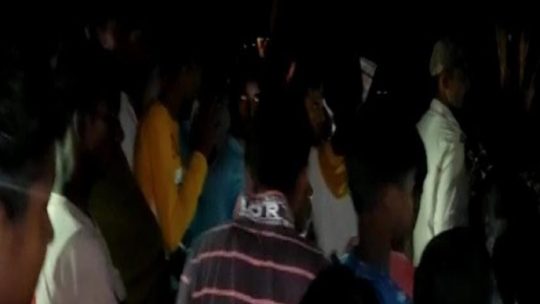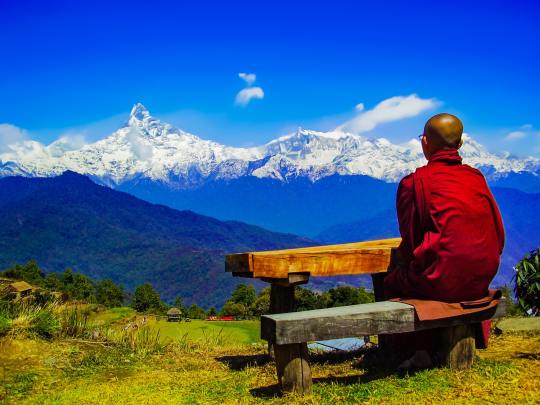#bihar rivers roaring
Text
Bihar Flood: नेपाल की तराई में लगातार बारिश से उफनाई नदियां, मिनटों का सफर घंटों में हो रहा तय
Bihar Flood: नेपाल की तराई में लगातार बारिश से उफनाई नदियां, मिनटों का सफर घंटों में हो रहा तय
आशीष सिन्हा
किशनगंज. सीमांचल के रास्ते दक्षिण-पश्चिम मानसून का बिहार में प्रवेश हो गया है. इसके प्रभाव से किशनगंज, पूर्णिया जैसे जिलों में बारिश हुई है. नेपाल में भी मानसून के सक्रिय होने से तराई के इलाकों में लगातार मूसलाधार बारिश हो रही है. नेपाल में तेज बारिश के कारण बिहार में नदियों का जलस्तर बढ़ने लगा है. सीमावर्ती जिलों में इसका परिणाम भी स्पष्ट होने लगा है. किशनगंज में भी स्थानीय…
View On WordPress
#bamboo bridge destroyed#bihar flood#bihar river water level rising#bihar rivers roaring#bridge washed away#flood in bihar#flood in kishanganj#flood like situation in bihar#heavy rain in nepal terai#monsoon rain in bihar#Rain in Bihar#retua river roaring#rivers overflowing#rivers roaring in bihar#किशनगंज में उफनाई नदी#किशनगंज समाचार#दक्षिण पश्चिम मानसून सक्रिय#नदी के उफनाने से पुल बहा#नेपाल की तराई में मूसलाधार बारिश#नेपाल में बारिश से उफनाई बिहार की नदियां#नेपाल में भारी बारिश#बाढ़ समाचार#बांस का पुल तबाह#बिहार में बाढ़#बिहार में बाढ़ जैसे हालात#बिहार में बारिश#बिहार में मानसून की बारिश#बिहार समाचार#मानसून हुआ सक्रिय#रेतुआ नदी उफनाई
0 notes
Text
Nawada News: नदी के तेज बहाव में फंसे दो युवक, किसी ने पेड़ तो किसी ने झाड़ी को पकड़ बचाई जान
Nawada News: नदी के तेज बहाव में फंसे दो युवक, किसी ने पेड़ तो किसी ने झाड़ी को पकड़ बचाई जान
Bihar News: बंगाल की खाड़ी में उठे चक्रवातीय तूफान गुलाब के असर से बिहार के कई जिलों में तेज हवा के साथ बारिश हुई. नवाजा जिले में भी इसका खासा असर देखने को मिला. नवादा में नदी के तेज बहाव में दो युवक फंस गए, जिन्हें कड़ी मशक्कत के बाद निकाला जा सका.
Source link

View On WordPress
#Bihae Weather news#bihar news#Nawada Heavy Rain#Nawada News#Nawada Police#Nawada Weather news#Rescue team#Trapped in roaring river#नदी के तेज बहाव में फंसे युवक#नवादा में मूसलाधार बारिश#नवादा मौसम अपडेट#बिहार न्यूज#बिहार मौसम अपडेट
0 notes
Text
Skip to content
Folklore expresses a culture – and translation builds the bridge between different cultures.
Kali of Kolkata – Chitreswari
november 7, 2018 by kathamukh

This story is based on history. The early 20th century author Jogendranath cites reference from Calcutta Review, volume III of 1845. I had to rewrite while presenting it for English-speaking readers of 21st century.
I was walking through Chitpur Road. Renamed as Rabindra Sarani, it was given a chance to associate itself with the Nobel-laureate Bengali poet Rabindranath Tagore. True, that the palatial ancestral home of Tagores is located by this road; but while renaming, did anyone ask the road whether it wanted to forget its colonial past or even the notorious Kali temple located here? – A sudden though crept in my mind. If not, why commoners in the locality still love to call this Chitpur Road, why do we still see nameplates before many old buildings here displaying the address as Chitpore Road? Local belief says that long before the road was made for motorized vehicles it derived its own name from the terrifying Chitreswari – form of goddess Kali, who once offered boon to devotees in exchange of human blood.
This is one road of much significance in old Kolkata. This crowded road was constructed later for trams and other vehicles by the British ruler, at a time when they developed Calcutta as a city to be suitable as the capital of India. India became one of their prestigious colonies from the very beginning of their coming here.
That day while walking, I heard the road telling me something whispering:
-“Do you know, I did not always look like this?”
-“You mean you looked different before?
-“Yes.”
-“How did you look previously then?”
-“That is your task to find out.”
The road went silent making me speechless. Only the vehicles kept on moving on it making noise as usual.
I knew what Chitpur Road told me was true. Probably it was trying to encourage me to tell the story of its past.
Long before the Battle of Plassey, the Dutch, Portuguese and British were engaged in trading in Eastern part of India. Current West Bengal became the centre of their activities. They conducted mainly import and export business from the business houses – locally known as Kuthi which they had built in cities and towns. The country was being ruled by Islamic rulers – Mughals were still in control from their throne in Delhi, though their power started decreasing and influence shrinking. The Nawabi throne in Subeh Bengal was seeing disputes – Aliwardi Khan became the ruler defeating the competitor Sarafraj. Anarchy overtook law and order in this area.
During that chaotic period, none could imagine Kolkata to emerge as an enormous city like today’s. Only three small villages, Sutanuti, Kolikata and Govindapur were human-habitats surrounded by forests and canals. Near Chitpur canal, one route starting from the bank of river Bhagirathi connected Sutanuti, Burrabazar, Kolikata, Govindapur and Chowringhee through its serpentine course before ending near the temple of Kalighat at the bank of Adiganga, an older course of Ganga. British settlers named it Pilgrim Road. This had no resemblance to the asphalt road we know these days. If we could go back few hundred years from now, we would find dense forests adjacent to Chitpur. Large Sundari and other varieties of trees lined up besides cane forest, long bushes, narrow and wide canals, water bodies, marshland and bamboo forests surrounding that narrow muddy track. These bushes and forests were inhabited by dacoits and slaughterers and burglars. Also the famous Royal Bengal tigers, wild boars and different venomous and non-venomous snakes were others inhabitants of this region. Tidal waves also created knee-deep muddy patches on the track in this low lying area. Our story evolved in that area called Calcutta by the European traders.
Kolkata in 17th\ early18th century
There were two old Kali temples in northern and southern end of this area. The one in the north was for Chitreswari Devi in Chitpur inside the forest on the bank of Bhagirathi. Legends tell that the dacoit-leader Chitreshwar established this Goddess and named her after own name – announcing own notoriety reflected by the Goddesses’ look. His Goddess Chitreswari looked as ferocious as Vargbhima of Tamluk, Kali of Kalighat or Yashoreswari worshipped by Pratapaditya. People believed that Chitreswar gained his power from some secret Tantric practice. He set out for his looting action leading own team every time after performing a special Puja in this temple. The indispensable offering of the Puja was human sacrifice. After the sacrifice, he asked for the Goddess’s blessings placing red hibiscus and other flowers and leaves from wood-apple trees (considered sacred leaves) at the idol’s feet. That offering’s staying on her feet for some time was considered to be the sign of her consent to their future heinous activities.
This temple is now far from the river that changed its course in the meantime. The other Goddess in the south end of the area was Kali in Kalighat. Pilgrims used to walk down to Kalighat through the long pilgrim’s road forming a large group after visiting the Goddess Chitreswari. Walking alone almost ensured death by tigers, snakes or dacoits on the way. Dacoits used to throw the dead bodies of pilgrims in the dense forests or canals after looting them. Killing the victims was part of looting process those days.
Chitreswar terrorized not only these three villages, but all the localities on the banks of the river. Local people called this De facto ruler of this area Chite dakat.
He used to lead a large gang of almost 500 people including thyangare – looters who killed before looting, stick fighters, sword-fighters, archers etc. Numerous pirates operating in this area used to work under him. His dominance was extended over neighbouring districts like Howrah, Hoogly, Nadia and Bardwan which fell within 200 kilometer radius from Calcutta.
The gang included people from different communities from different regions – some from Bihar, some from Odisha, some were Gypsies and some Mohammedan. They were so well organised that catching hold of them became difficult for the administrators. Whenever they anticipated the threat of being caught, they fled to some remote village in Chandernagore, Hoogly or Burdwan – making all the efforts to catch them futile.
Chite dakat was extraordinarily desperate who seldom left his own forest fortress. He used to perform Puja in his own temple reciting own chants. None had an idea what exactly the chants were.
The defiant Chite looted the merchandise ships of East India Company between Kolkata and Murshidabad. Govindapur was, in fact famous as business hub of cotton and cotton yarn. Ships loaded with cotton yarn were frequently attacked by his gang. They invariably killed the sailors after looking the cargo. Another group controlled by him was into looting small cargo boats carrying salt from Hijli using same Modus operandi. River transport was the main option for carrying goods those days. Ships and boats en route between Kolkata, Murshidabad and Dhaka were being looted so often that not only common people, also traders had to be extremely cautious while travelling. The gang of Chite earned infamy for being even more ferocious than Portuguese pirates.
At some point of time, East India Company realized the necessity of finding a solution for this. Chite became irresistible also as burglar invading wealthy people’s mansions. The Brobdingnagian size of his gang and the inaccessibility of his abode in the dense forest was main obstacle for Company.
Chakrapani Datta, a commander of Bengal Nawab’s army had ancestral home in Chitpur. The Kayastha* nobleman was gallant fighter. He stayed either in Gaud or Murshidabad, capital of Bengal at that time. Once he came to visit Chitreswari temple along with his family members. The dacoits dared attacking this wealthy administrator’s group too. Chakrapani Datta, like all other influential aristocrat, travelled well-armed. Also the local villagers came forward to help his family. Chitreswar could not succeed. But the Nawab’s commander took an oath to demolish the dacoit gang after this incident. He began consulting with officials of Bengal Nawab and East India Company regarding this.
Chitpore Nabaratna Kali temple in 1798 – destroyed in natural disaster.
It was the new moon night of a Saturday – the auspicious day for traditional criminals. The dacoit’s team met in the temple’s courtyard.
The auspicious time for worshipers was in the middle of the night. The night was silent; not even the trees in forest dared to break the silence it seemed. Only the sound of some wild tigers roaring somewhere far from there was announcing the existence of life in the earth. The Puja was being performed by two priests – one Tantrik and the other – Chitreswar himself. They collected all necessary materials for this Tantric form of worship – only the human body was left. The ferocious long haired Goddess, standing on the corpse, wearing human skulls and holding sacrificial axe seemed to be waiting for human blood. Where to find the human offering? The Tantrik priest smeared in red sandal paste continued muttering prayers while counting the conch-shell garland.
A young handsome Brahmin was walking alone towards Kalighat at that time. He missed the group of pilgrims he was supposed to come along. The dacoits hunting for a man did not miss the chance of catching him. He was brought before the Idol. The wild idol in the violent ambiance frightened the young man. He requested them – “Don’t kill me, I am a Brahmin* – only child of my widowed mother.”
The barbarous gang-leader yelled at him – “The Goddess calls you. You have nothing to be scared!” Gang members dragged the man towards the sacrificial post. The Brahmin found no other way but to scream for help as loud as possible and forcibly making himself free. Fortunately, he was strong enough to push those brutal yet drunk dacoits. Calling for help he began running towards the Pilgrim’s road. The gang chased him, but failed to catch him. Another large group of pilgrims was coming towards the temple following the same route. This group went to Kalighat at first and then started for Chitreswari temple. They lost their way in the dense forest and found the it again late in the evening. The prey was miraculously rescued.
Chitreswari’s puja was disrupted that night. Even the offering was missed. Did this frighten Chitreshwar?
Chitreswar was preparing for the Puja once again after the Brahmin youth ran away. Other gang members were guarding the place. All on a sudden, the combined force of the Nawab and Company attacked them. They surrounded the temple from all corners of the forest, making it impossible for the dacoits to flee. The leader too tried to, but could not succeed. He was convicted and sentenced to death to law of those days. People believed catching him was possible because he could not complete the ritual of human sacrifice that night. A properly completed Puja of the Goddess Chitreswari would keep him irresistible as ever.
The temple and Goddess were abandoned for sometime after Chitreswar was caught. People started worshipping her again at a later point of time. From the same clan emerged Raghu Dakat – another infamous dacoit who operated after a few decades.
(illustrations from Wikimedia commons)
* Kayastha – Hindu upper caste – was mainly engaged in administrative and legal jobs at royal courts in Pre-British Bengal.
*Here we see conflicting religious practices in the name of Hindu rituals. Brahmin, as a caste was on the one hand considered to be of higher quality and that’s why killing a person of Brahmin origin was considered to be a sin as per puranic tradition. People believed that a killer of Brahmin would be sent some treacherous hell after his death. On contrary, young Brahmin male, preferably a handsome one without any scar or defect in the body was considered to be best sacrificial offer to God according to Tantrik tradition.
© Kathakali Mukherjee, 2018
tagged folktales, hindu goddess, kali, legends, west bengal
POST NAVIGATION
PREVIOUS POSTA story found in my dreams
NEXT POSTFolktales from Bengal
LEAVE A REPLY
Logged in as kathamukh. Log out?
COMMENT
Notify me of new comments via email.
This site uses Akismet to reduce spam. Learn how your comment data is processed.
BLOG STATS
3,247 hits
Enter your email address to subscribe to this blog and receive notifications of new posts by email.
Join 757 other followers
Email Address:
SUBSCRIBE
Create a free website or blog at WordPress.com.
3 notes
·
View notes
Photo

Begusarai a district of Bihar. One of the oldest district lies on the northern bank of river Ganga. Begusarai is getting ready to Roar for Justice for Sushant Singh Rajput. Let's join. #Begusarai4SSR PMO Fair Justice 4 Sushant https://t.co/x3sTosn3Gm https://t.co/MCU7F5pEfn https://www.instagram.com/p/CSI_tlFDtNH/?utm_medium=tumblr
0 notes
Text
World + Peace: Amazing World Places to Meditate
February 17, 2019
8:18am
Naples, Italy (From a Hostel Bed)
Today is my birthday and I’m full of so much gratitude. So much gratitude, in fact, that I feel the need to share it with whoever needs some and whoever wants some. Trust me, there’s plenty here to give.
I’m traveling right now, I am in the middle of the India tours, meeting strangers, eating new dishes, taking photos of beautiful mountainsides because they’re all a major part of my self-care. I woke up this morning ad before checking Instagram, Facebook, text messages, or missed calls, I opened my Insight Timer app and found Annemaree Rowley’s 16-minute guided “Gratitude” meditation. Today, I’ll be intentional about recognizing and reflecting on the great things I’ve been gifted and to show kindness toward others when the opportunity arises.
As a gift to you folks who, like me, believe in the power of mindfulness and meditation and compassion, I want to share some of the most amazing places in which I’ve allowed the universe to speak to me. Some are meditation centers and others are simply amazing places to find peace of mind. For the centers, descriptions are provided by their respective site:
1. Plum Village: “Near Bordeaux in southwest France, is the largest international practice center in the Plum Village tradition, and the first monastic community founded by Zen Master Thich Nhat Hanh (Thay) in the West.”

2. Big Sur, California: To describe the beauty here, you must believe in fiction. Justin Michael Williams told me about this place. He saw to drive down, arriving a couple of hours before sunset, and to breathe and just take it all in. I did. I often find myself wanting to hop in a car and just go for a few hours.
3. The Buddhist Retreat Centre, KwaZulu-Natal, South Africa: “Perched on a ridge at the head of a valley in the Umkomaas river system in KwaZulu-Natal, the Buddhist retreat Centre looks out on a vista of indigenous valleys, forests and rolling hills receding like waves in the blue distance. Here, for more than twenty years people of all religions have come to experience peace and tranquillity. It is a gentle, sympathetic space where one can be still and get in touch with oneself and reflect on the things that crowd one’s life. CNN featured the BRC as one of the 10 finest Meditation centres in the world (From their site).”
4. Wat Suan Mokkh, Chaiya, Thailand: “Meditation is a way to train and cultivate the mind, to develop con¬cen¬tra¬tion, mind¬ful¬ness and aware-ness. Bud¬dhism offers calm¬ness or con¬cen¬tra¬tion medi¬tation and vipassana or insight medi¬tation. Ana¬pana¬sati or Mind¬ful¬ness with Breathing, the medi¬tation method taught at Suan Mokkh, covers both, con¬cen¬tra¬tion and insight medi¬tation. But during the first days of the retreat we will mainly train you in con¬cen¬tra¬tion medi¬tation by focusing at¬ten¬tion on breathing. Detailed in¬struc¬tion is given through-out the retreat. All in¬struc¬tion and talks are given in English (From their site).”

5. Auyán-tepui, Venezuela: With the roar of the world’s highest uninterrupted waterfall in the distance, this is an amazing place to have a rest while on an unforgettable hike and get into some contemplative practice. Surely this is one of those places where guided meditation leaders wouldn’t mind if you were to lay in your hammock while listening.
6. Entrelacs, Quebec: This is where I had one of my most amazing meditation moments of 2017. I rented a beautiful cabin with no electricity or running water in the middle of the forest with others and we sat around the fire, talking about it all. When I freed a bit of time, I walked to where the boats were kept, sat in the canoe, closed my eyes and let the universe guide me. When I came to, I was in the middle of the lake surrounded by some of the most beautiful landscape. A few months later, I was in South Africa, tattooing the Entrelacs trees on my wrist.

7. Kata Bay, Phuket, Thailand: Here, you’re removed from the sound of cars, feet shuffling, babies crying, and hustlers. You can be alone with your thoughts on one of the world’s most beautiful bays. If you grow tired of the solitude quickly, don’t fret. There are others nearby in hotels and resorts.
8. Bodhgaya, Bihar, India: Because…well…you know.
9. Wherever You Are: Getting away physically isn’t always possible, but making space where we are can be – even if just a second. Find your own serene, private spaces and escape to them whenever you need. Here’s a way to make that happen, according to Mind Body Green and Claire Charters:
A. Choose a room or space that makes you feel good.
Take into consideration the lighting, the quietness and how many people walk through it. Will it be a place of solace? If you don’t have a whole room to dedicate to your sacred space then choose a corner of a room, or somewhere in your garden. You may even like to put up a bamboo screen to create the feeling of a separate space.
B. Keep the room simple and uncluttered.
Choose a few items that find bring you peace and serenity. Some basics would be a meditation pillow, a small table, a mat and maybe a nice throw rug.
C. Add a touch of nature.
Meditation is all about connecting with nature and your surrounds. By adding an element of nature, you space becomes infused with balance and harmony. You can place your favourite plant, a vase of flowers, a jar of shells, a small water feature or whatever else it is that you find beautiful in nature.

D. Soothe your soul with music.
Music is not necessary however if you live in a noisy city, a piece of soothing music or chants will help bring tranquillity and peace. Alternatively, you can add a small fountain in your meditation room. The crisp trickling sound of water will also make the room soothing and serene.
E. Create a beautiful aroma.
It helps you stay focused and fills your space with beautiful and soothing energies. You can put some incense, aromatic oils or candles with meditative scents in the room. If you use candles, it can be very meditative to just watch the flame flicker.
F. Personalize your space.
To make your meditation space more personal and tranquil, you can add anything that soothes your soul. You can add bells and chimes, a statue of Buddha, affirmation stones, crystals, beads or any artwork that provides you with immense peace and serenity. You can also get the room painted in your favourite colors.
If you download the Insight Timer app, or if you already have it, please feel free to add me as a friend.
“If you want to conquer the anxiety of life, live in the moment, live in the breath.”
― Amit Ray
World + Peace: Amazing World Places to Meditate was originally published on Passport Required
#Best Places to Meditate#How to Meditate#Insight Timer#Meditating#meditation#Mindfulness#Travel#Traveling#Tumblr Travel Photography#TumblrTravel
0 notes